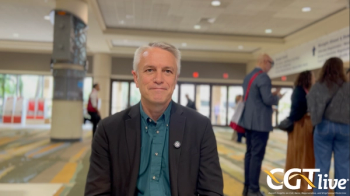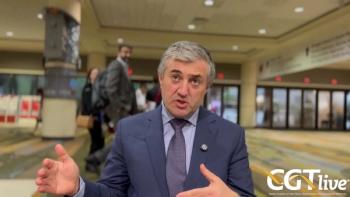
Adding Rituximab to Chemo Boosts Survival in Subgroup of ALL Patients
Two-year event-free survival increased from 52% with conventional therapy to 65% with the addition of rituximab among patients with newly diagnosed, CD20-positive Philadelphia (Ph)-chromosome negative B-cell precursor acute lymphoblastic leukemia, according to results from a phase III trial.
Rituximab, a long-time therapeutic staple for lymphoma, has demonstrated potential for improving outcomes in certain patients with acute lymphoblastic leukemia (ALL) as well, according to findings of the phase III GRAALL-R 2005 study.
The randomized trial showed that 2-year event-free survival (EFS) increased from 52% with conventional therapy to 65% with the addition of rituximab among patients with newly diagnosed, CD20-positive Philadelphia (Ph)-chromosome negative B-cell precursor (BCP) ALL.
“In this subgroup of patients with ALL, the addition of rituximab to standard intensive chemotherapy is well tolerated and significantly improves EFS,” said Sebastien Maury, MD, a hematologist at Hopital Henri Mondor in Creteil, France, who reported the findings at the ASH Annual Meeting. “The addition of rituximab also improves overall survival in patients who are not receiving allogeneic stem-cell transplantation in first complete remission.”
“On the basis of these results, adding rituximab to standard therapy should thus become a standard of care for these patients,” Maury added. “The optimal dose schedule of rituximab administration remains to be determined.”
Rituximab is a chimeric monoclonal antibody against the B-cell surface antigen CD20. Introduction of the antibody has led to significant improvement in the treatment of B-cell non-Hodgkin lymphoma, including Burkitt lymphoma and leukemia, Maury noted.
In about 30% to 40% of cases, BCP-ALL exhibits expression of CD20 at diagnosis. Several studies have found CD20 to be a marker of unfavorable outcomes, and at least one historical study has suggested potential benefit from adding rituximab to conventional chemotherapy for patients with BCP-ALL (J Clin Oncol. 2010;28(24):3880-3889).
The potential benefits of adding rituximab to treatment of BCP-ALL had not been evaluated in a randomized trial, providing a rationale for this multicenter France- study reported at ASH. Investigators enrolled patients aged 18 to 59 years who had at least 20% non-Burkitt ALL blasts in bone marrow.
Patients were randomized to receive a standard chemotherapy regimen for BCP-ALL with or without rituximab dosed at 375 mg/m2. Patients assigned to the rituximab arm received the antibody during induction, salvage reinduction (when needed), consolidation, and late intensification, followed by a year of maintenance rituximab. Altogether, patients in the rituximab group received 16 to 18 doses of the antibody.
The trial had a primary endpoint of EFS and was designed to detect a 20% improvement in EFS with the addition of rituximab at 2 years. Investigators at 56 centers randomized 220 patients, 209 of whom were included in the intention-to-treat analysis.
The complete response rate after induction and reinduction therapy was 91% with chemotherapy alone and 92% with rituximab. In the patients who achieved complete response, rates of minimal residual disease (<10-4) after first induction were 65% with rituximab and 61% without, and 91% versus 82% after induction and the first three cycles of consolidation therapy. Neither difference was statistically significant.
Significantly more patients in the rituximab underwent stem-cell transplantation after complete response (34% vs 20%, P= .029).
After a median follow-up of 2 years, significantly fewer relapses had occurred in the rituximab arm (18% vs 30.5%, P = .02). Nonrelapse mortality was identical at 12%.
The 13% absolute difference in EFS translated into a 34% reduction in the hazard ratio in favor of rituximab (HR, 0.66, P = .038). Analysis of overall survival demonstrated a trend in favor of rituximab (71% versus 64%), but the difference did not achieve statistical significance (HR, 0.70, P = .095).
Multivariable analysis identified treatment with rituximab as a significant predictor of EFS (HR, 0.64, P = .030), along with age (HR, 1.02, P = .022), white cell count ³30 x 109/L (HR, 1.97, P = .002), and central nervous system (CNS) involvement (HR, 2.35, P = .011).
Maury and colleagues performed a multivariable analysis that censored patients at the time of stem-cell transplantation. The analysis resulted in a 2-year EFS of 66% with rituximab and 53% without (P =.021) and overall survival of 74% versus 63% (P = .018).
Treatment with rituximab remained an independent predictor of EFS in the analysis, as did age, white-cell count, and CNS involvement. Maury said that stem-cell transplant in first remission did not significantly affect the EFS hazard.
Maury S, Chevret S, Thomas X, et al. Addition of rituximab improves the outcome of adult patients with CD20-positive, Ph-negative, B-cell precursor acute lymphoblastic leukemia (BCP-ALL): results of the randomized GRAALL-R 2005 study. Presented at: the 57th Annual Meeting of the American Society of Hematology; Orlando, Florida; December 5-8, 2015. Abstract 1.
<<<
Newsletter
Stay at the forefront of cutting-edge science with CGT—your direct line to expert insights, breakthrough data, and real-time coverage of the latest advancements in cell and gene therapy.




































